
It began with an inspiration and required two years of perspiration and frustration, but High Desert Organics (HDO) will soon offer the local community a much-needed compost facility.
It began with an inspiration and required two years of perspiration and frustration, but High Desert Organics (HDO) will soon offer the local community a much-needed compost facility.
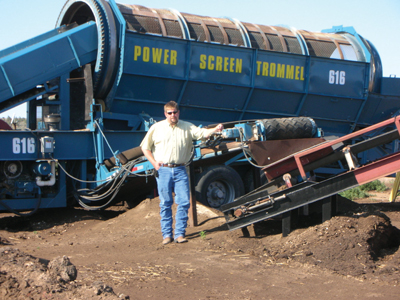 |
| Greg Williams with High Desert Organics’ trommel screen. Submitted photos. |
As a full-time farmer and field rep for Central Oregon Seeds, Greg Williams understood what a big issue agricultural waste was in Jefferson County, Ore.
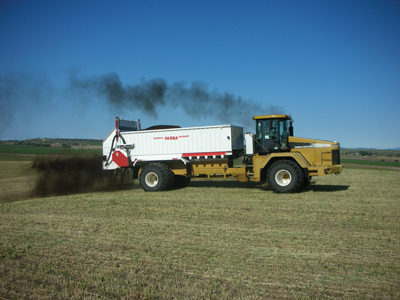 |
|
| The adapted TerraGator can spread three to five ton with close to 100 percent accuracy using a Falcon control system with Trimble GPS. |
|
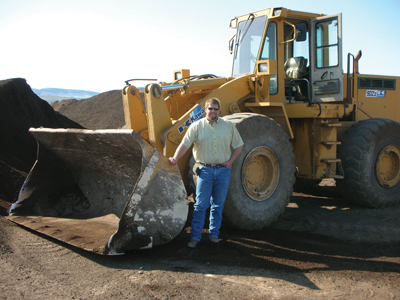 |
|
| High Desert Organics also uses two 400 Cats, two Freightliner trucks, plus two Red River belt trailers and a Ray-Man conveyor in its operation. |
|
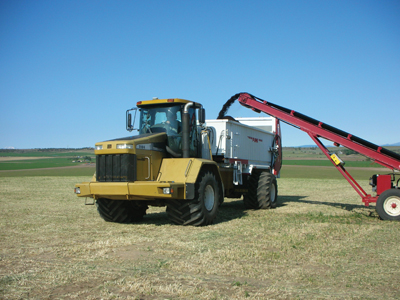 |
|
| Zen Wilson waits in High Desert Organics’ modified TerraGator as the spreader box is filled with compost. |
|
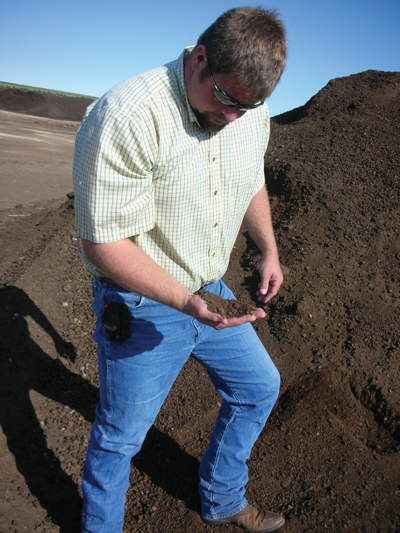 |
|
| Greg Williams holds a sample of the dry manure screenings his company, High Desert Organics, is applying to Oregon cropland. |
|
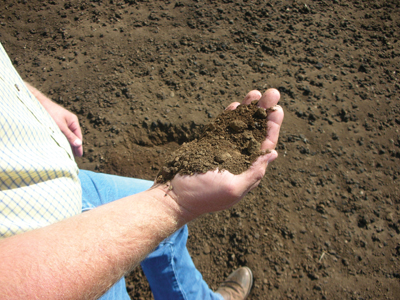 |
|
| The dry manure has been put through a trommel screen and then composted and turned before being land applied. Advertisement
|
“Our company has quite a bit of waste from screening products like grass seed, mint leaf, carrots and parsley and others,” says Williams. “Because of the nature of the product, it’s light and bulky and the landfills didn’t like it. It also couldn’t be used for feed, so we just started dumping it out on some range ground and stockpiling it.”
In 2006, while watching television, Williams saw the solution. “It was a show on composting and I thought ‘That’s a fantastic idea!’”
A simple plan derailed
Williams and his friend and neighboring farmer, Ryan Boyle — each with 2,500 irrigated acres and running cattle on rangeland — decided to join forces and create a large-scale composting operation called High Desert Organics.
Their plan was fairly simple. They would bring in manure from nearby feedlots and blend it with the screenings from Central Oregon Seeds and sell the material wholesale to large operations like nurseries or spread it on farms.
Thinking it would be an easy process and welcomed in a county with a $73 million agriculture industry and no outlets for waste, the two men purchased 40 acres of ground. The solution seemed obvious — there would be a use for the waste generated and the farmland in the area that had been depleted of micronutrients over the past 30 years would get a healthy boost.
Wanting to do it right, Williams and Boyle began filing for permits. Williams also went to his neighbors to explain what they were planning.
“One neighbor thought it was a great idea but the other looked worried,” says Williams.
It turns out the neighbor was worried about dead animals. It was true the permit Boyle and Williams had applied for allowed them to compost animals as well as bio solids, but they had no intention of doing either.
“Unfortunately, there isn’t a permit out there that says, ‘You can compost just your manure and screenings,’” says Williams.
Immediately after speaking with Williams, the neighbor sent out 1,000 fliers around the county to drum up money and support to fight HDO.
“It was just full of false accusations,” says Williams. “And it was bad because it started us out on the wrong foot.”
The next two years looked something like this:
| • | Williams and Boyle apply for permits in early 2007. |
| • | Planning commission likes idea, but requires the site to be moved. Compost sites can’t be located on land zoned as high-value farm ground. |
| • | Nearly 10 months are spent searching for a new site and feasibility studies are done on 3,600 possible options. |
| • | Spring 2008, Williams and Boyle reapply for a permit. |
| • | Fall 2008, the commission approves the plan and issues a permit. |
| • | Neighbors immediately file suit. |
| • | New hearing to be held June 24, 2009, for final determination. |
| • | (Neighbors could appeal, but it will be an expensive proposition.) |
Taking it to the feedlot
During the two-year permitting process, the men have veered from composting and gone into the feedlot clean-up business to make use of the equipment they had purchased for composting and to pay the ongoing attorney and engineer fees.
“We’ve been going in and cleaning up feedlots and screening the manure,” explains Williams. “The real wet manure is what we want to go back into the compost. But the old, dry manure we like to screen it and get a fine product because obviously the smaller the particle size, the higher the nutrient value to a plant.”
In short, they are composting on a small scale at the feedlots, using a trommel screen to screen the dry manure. It’s then piled and kept at approximately 150 F to ensure the weed seeds are killed. A Frontier turner manufactured out of Oregon’s Willamette Valley is used to turn the piles. “It’s worked very well for us,” says Williams. “It’ll turn piles eight foot by 12 foot.”
HDO blends in lime and gypsum and, once the piles have finished composting, HDO applies the compost on alfalfa and wheat fields, as well as on fallow ground.
“We sell (the materials from the feedlots) to other local farms and spread it as well,” explains Williams. “Because of the nutrient values that we’re getting using the manure, it’s well worth putting the manure on.”
HDO’s additional equipment includes two Freightliner trucks, two 400 Cats, as well as two Red River belt trailers and a Ray-Man conveyor that loads the spreaders.
“We also use an Ag-Chem spreader that was originally designed as a manure injection system,” explains Williams. “We tore off the injection system and put a (Parma) spreader box on. Now we can spread three to five ton with about 100 percent accuracy using a Falcon control system with Trimble GPS.”
Moving forward
The new site HDO chose is two miles east of the original site and located on rangeland. New roads have yet to be constructed, but an unlimited water supply is already secured.
“At peak season, when it’s 105 to 110 F, zero humidity, we could use around 60,000 gallons a day. During the winter though, we’ll very seldom use water,” says Williams.
Williams and Boyle estimate that five semi trucks a day will bring in wet manure and other agriculture waste. At this point, they anticipate several hundred thousand pounds of material arriving on the site annually.
The site will only receive bulk suppliers. “An average Joe with a pickup won’t be able to come out and drop their waste off. He’ll have to take it to a site in town and then we’ll take our semis in and get it,” says Williams.
Even though the piles will continue to compost throughout the winter, in optimum conditions —temperatures inside the piles maintained between 130 and 180 F — HDO believes materials will be composted within two weeks.
There is real value in their compost because of the manure’s content, but the flip side is the weed seeds it can sometimes contain. For that reason, in addition to killing the weeds at high temperatures, they generally leave the compost in bulk piles for three to four months before spreading it.
“The biggest issue will be keeping the piles aerobic. You don’t want them to become anaerobic because then they start getting stinky,” says Williams.
HDO looks forward to expanding. Although the company sees itself as a wholesale compost outlet for bulk buyers, Williams says he can foresee the day when they are bagging and selling it as well.
“Right now, we’re trying to keep customers within a 40-mile radius, because of the difficulty in moving equipment,” he says. “But if the company grows, we would purchase more equipment and spreaders.”
Already producing positive results
Although they aren’t quite in operation, HDO already has a list of potential customers. Maybe that’s in part because High Desert Organics is already seeing positive results.
“We soil test all our fields three times a year and we’ve seen improvements,” says Williams. “Using the manure with lime and gypsum, it’s bringing up the potassium and phosphorus levels. There’s definitely been an improvement in our crops as well.”
Right now, HDO employs two full-time employees and two part-time employees. Zen Wilson, the company’s operations manager, is doing a great job for them, says Williams.
“When we’re up and running, we’ll have between three and four employees, including the truck drivers, the spreader operator and generally a guy at the feedlot screening,” he adds.
Lessons learned
Williams says if he had it to do over again, he would start with local government and the local regulations with respect to composting.
But despite the struggle and setbacks, Williams says some good has come from all this. “People have become aware of just how much agricultural waste there was in the area and that there are people who are stepping forward and trying to solve some of the problems.”
Composting, he says, is the way of the future. “I believe in the U.S., 42 states have already closed landfills,” says Williams. “In my opinion, that’s the way it ought to be. Most everything can be recycled or composted. They are doing it all through Europe, and it’s just amazing how far behind we are on recycling tradition.”
The compost facility may become a reality after this last hearing, but if the neighbors appeal, don’t expect it to deter either Williams or Boyle. In fact, a growing support may be giving them their second wind.
“We’re getting contacted from all over the state by people who are interested in this project,” says Williams.